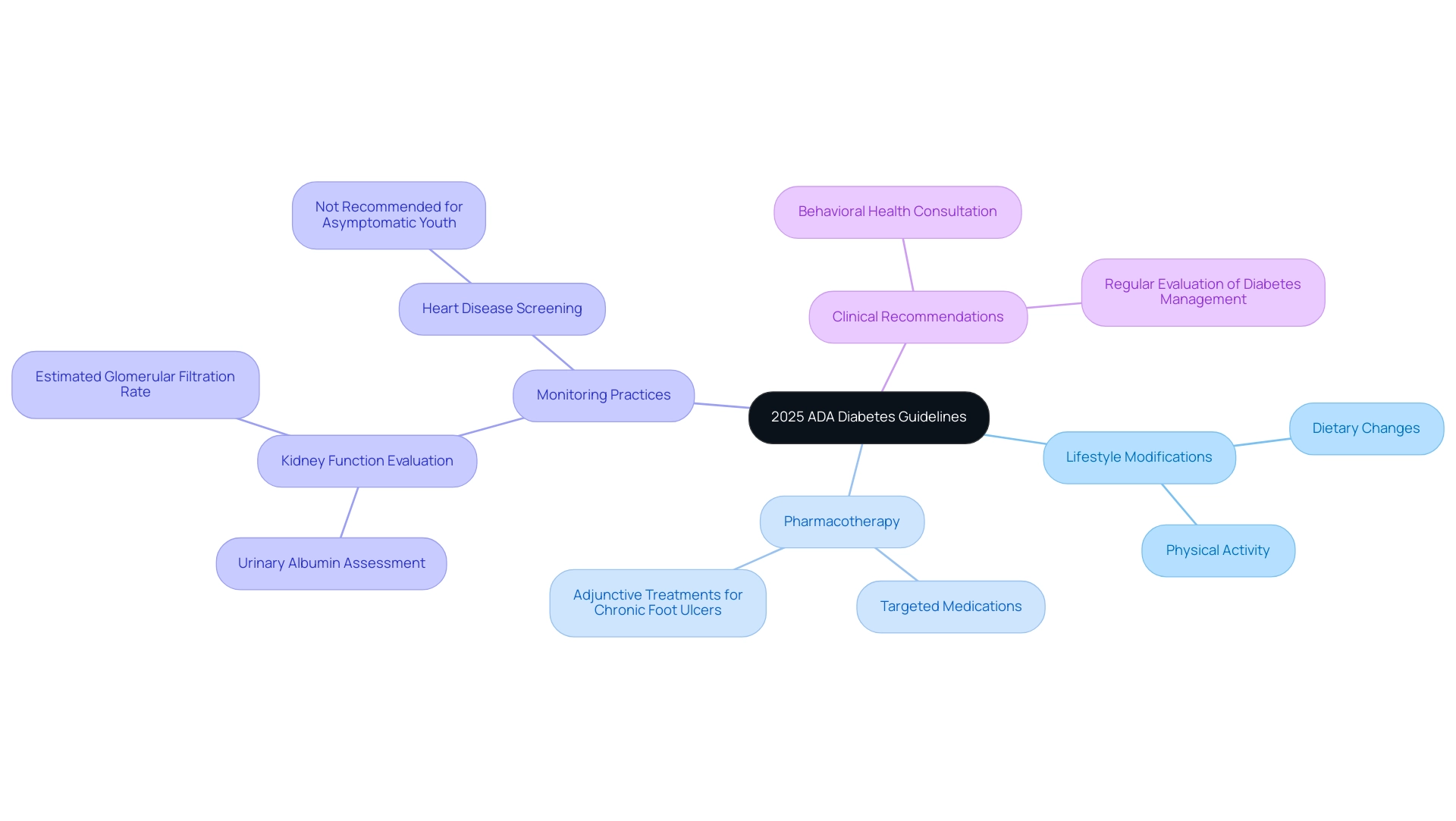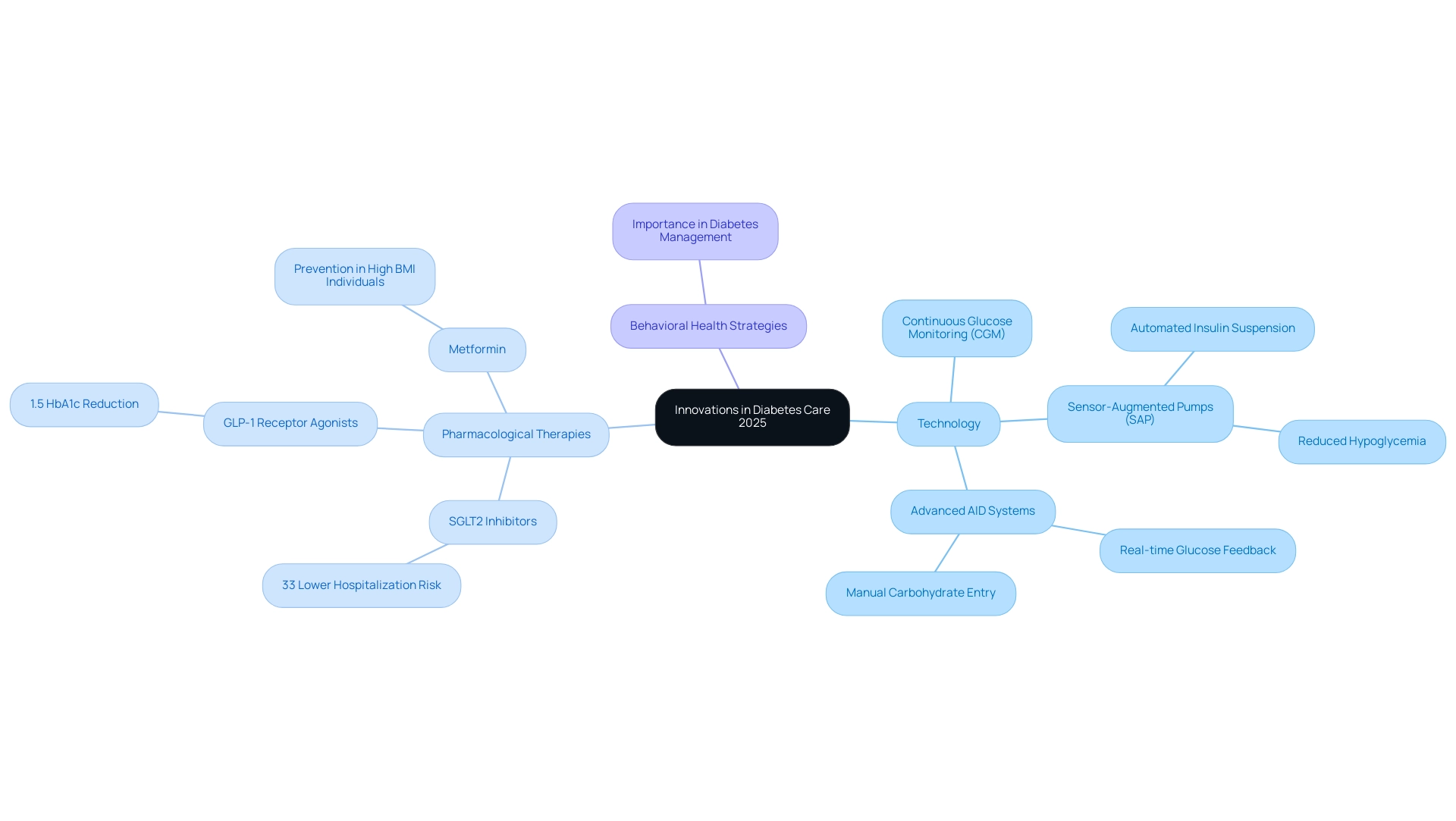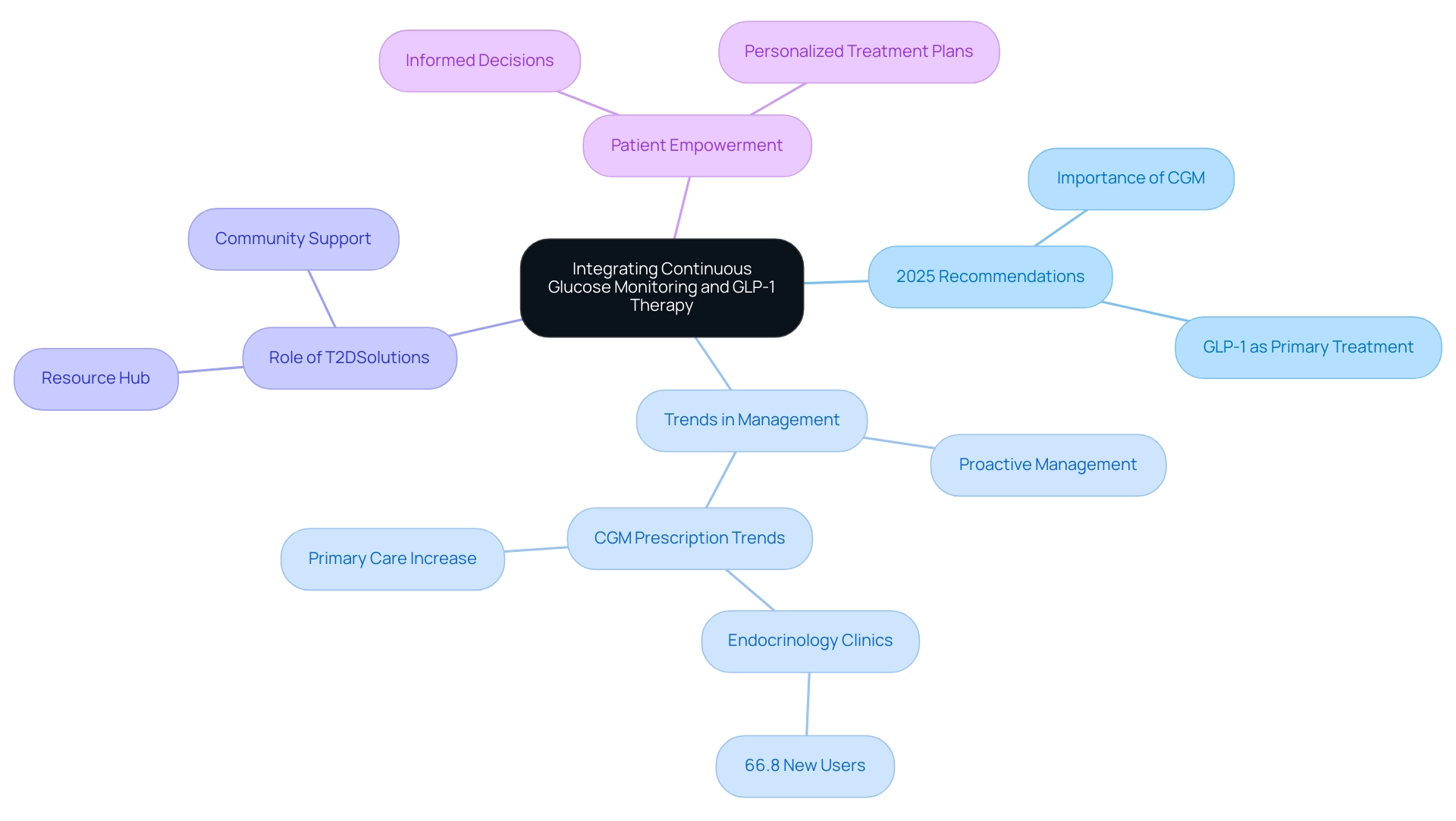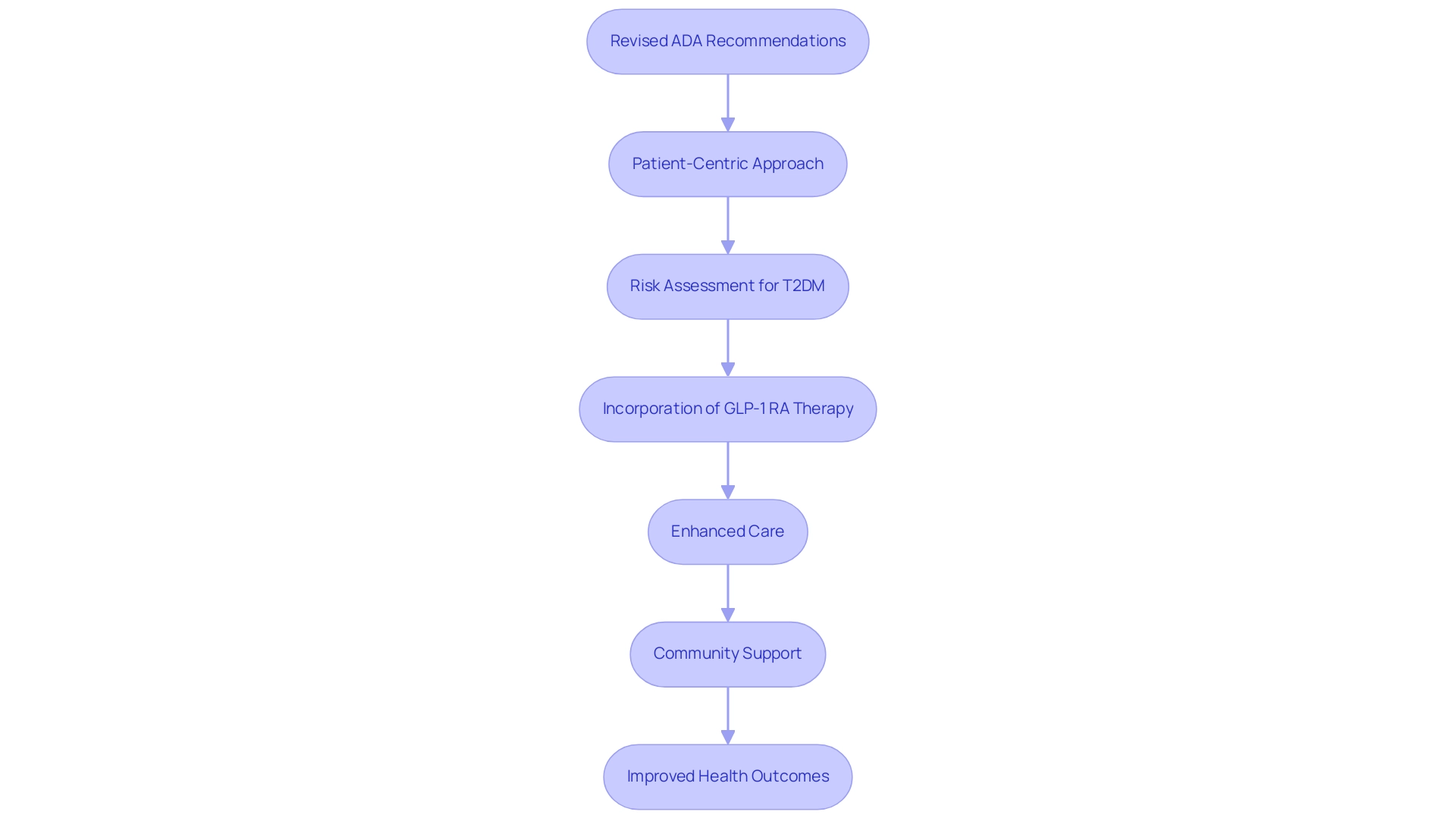Overview
The ADA Diabetes Guidelines 2025 aim to enhance diabetes management through evidence-based strategies, focusing on lifestyle modifications, targeted pharmacotherapy, and rigorous monitoring practices. The article supports this by detailing key updates such as the recommendation of Continuous Glucose Monitoring and GLP-1 receptor agonists, which are crucial for personalizing treatment and improving patient outcomes in diabetes care.
Introduction
The 2025 ADA Diabetes Guidelines represent a significant leap forward in the management of diabetes, reflecting the latest research and clinical insights to enhance patient care. These guidelines are designed to equip healthcare providers with evidence-based strategies that address a wide range of diabetes management aspects, from lifestyle changes to advanced pharmacotherapy.
Notably, they emphasize the importance of personalized care, advocating for:
- Routine assessments of kidney function
- Careful monitoring of cardiovascular health
- Cutting-edge technologies like Continuous Glucose Monitoring (CGM)
- Innovative treatment options such as GLP-1 receptor agonists
As the landscape of diabetes care continues to evolve, understanding and implementing these guidelines is crucial for clinicians aiming to improve patient outcomes and quality of life for those living with diabetes.
Overview of the 2025 ADA Diabetes Guidelines
The ada diabetes guidelines 2025 represent a crucial progression in the treatment of diabetes, incorporating the latest research and clinical advancements to enhance handling practices. These ada diabetes guidelines 2025 are meticulously crafted to aid clinicians in adopting evidence-based strategies that enhance management of the condition. They cover a broad spectrum of recommendations, including essential lifestyle modifications, targeted pharmacotherapy, and rigorous monitoring practices.
Notably, routine screening for heart disease with electrocardiogram, echocardiogram, or stress testing is not recommended in asymptomatic youth with type 2 conditions, emphasizing a targeted approach to care. Furthermore, regular evaluation of kidney function is essential for individuals with type 1 condition who have experienced it for five years or more, as well as for all individuals with type 2 condition. Monitoring includes evaluating urinary albumin and estimated glomerular filtration rate to manage kidney health effectively.
Every element of the recommendations is crafted to enhance patient results and elevate the overall quality of life for individuals managing their condition as outlined in the ada diabetes guidelines 2025. R.G.M., co-chair for the 2025 Standards of Care, emphasizes the significance of these protocols: 'A PPC chair or co-chairs are appointed by the ADA, and oversee the committee.' Understanding the ada diabetes guidelines 2025 is essential for healthcare professionals as they work to provide the best support and adapt to the evolving environment of blood sugar regulation.
By implementing these standards, clinicians can significantly influence the trajectory of their patients' health, ensuring a more effective and personalized approach to managing their condition. A2D Solutions, we strive to offer educational materials that correspond with these standards, enabling recently diagnosed individuals with the information and assistance they require to handle their condition effectively.

Key Updates and Innovations in Diabetes Care for 2025
The ada diabetes guidelines 2025 for blood sugar disorders showcase substantial progress, particularly in technology and pharmacological therapies, which T2D Solutions intends to support as a resource center for education and care. Notable innovations include Continuous Glucose Monitoring (CGM) systems, which provide real-time glucose data, and new pharmacological agents such as SGLT2 inhibitors and GLP-1 receptor agonists. Recent research suggests that SGLT2 inhibitors can lower the risk of hospitalization for heart failure by up to 33%, demonstrating their efficacy in blood sugar control.
Furthermore, GLP-1 receptor agonists have demonstrated a reduction of HbA1c levels by an average of 1.5% in clinical trials, further improving glycemic control and personalizing treatment. As Megan, a licensed nurse with extensive experience in managing blood sugar conditions, observes,
As a former community health nurse with extensive coordination experience working with patients, I’m excited to see innovations in treatment advancing. However, I also hope that insurance coverage keeps pace to ensure these technologies are accessible to those who need them most.
Additionally, the ada diabetes guidelines 2025 emphasize the importance of incorporating behavioral health strategies into blood sugar management, recognizing the psychosocial elements that greatly influence diabetes control. Clinicians are encouraged to familiarize themselves with the ada diabetes guidelines 2025 to deliver comprehensive care tailored to the unique needs of their patients. A real-world example of technology's impact is illustrated through Sensor-Augmented Pumps (SAPs), which have effectively reduced hypoglycemia by automating insulin suspension during low glucose events.
Although these systems have been largely replaced by more advanced AID systems, they still provide valuable benefits in managing glucose levels. Additionally, it is recommended that metformin be considered for preventing or delaying the condition in individuals with elevated glucose measurements and a body mass index >35 kg/m.

Integrating Continuous Glucose Monitoring and GLP-1 Therapy
As T2DSolutions launches as a brand new resource hub for Type 2 and Type 3 blood sugar management education and community support, we emphasize the importance of the 2025 recommendations. These recommendations strongly support Continuous Glucose Monitoring (CGM) as a crucial standard for managing blood sugar levels, offering real-time insights into glucose fluctuations. This empowers newly diagnosed patients and healthcare providers to make informed decisions regarding insulin administration and dietary adjustments.
Recent studies highlight a trend toward more proactive management of blood sugar conditions, with endocrinology clinics initiating CGM prescriptions for a significant number of new users. Additionally, the ADA diabetes guidelines 2025 recommend GLP-1 receptor agonists as a primary treatment strategy for individuals with Type 2, particularly those with concurrent cardiovascular issues or obesity. By personalizing treatment plans to align with the unique needs of each patient, clinicians can enhance care outcomes.
T D Solutions is dedicated to being a valuable resource in navigating these advancements in blood sugar control, providing relevant information and support to our community. To stay updated on our latest content and resources, we encourage you to subscribe for email notifications.

Implications for Clinical Practice and Patient Outcomes
The revised ADA recommendations for 2023 and 2024 carry significant consequences for clinical practice, mainly by promoting a more patient-focused method for managing blood sugar. This shift is critical, especially considering that approximately 240 million people are currently living with undiagnosed blood sugar issues, highlighting the urgent need for effective management strategies. The recommendations highlight that adults with type 2 diabetes mellitus or prediabetes and a FIB-4 >1.3 should undergo further risk assessment to better customize their treatment plans.
The incorporation of the latest treatment options, including the newly recommended GLP-1 receptor agonist (RA) therapy for individuals with type 2 conditions and heart failure, allows clinicians to provide enhanced care tailored to individual patient needs. These advancements are anticipated to result in enhanced glycemic control, fewer complications, and improved overall health outcomes for individuals managing their condition.
As T2DSolutions launches as a new resource hub for Type 2 and Type 3 education and community support, it will offer valuable insights into how these updated guidelines can be utilized effectively. The significance of social capital and community support is clear in managing the condition, as illustrated in case studies that reveal a connection between robust support systems and improved health results. Community health workers and paramedics play a crucial role in providing education and support for managing blood sugar conditions, particularly in underserved communities, ensuring that individuals have access to the resources they need.
Conversely, factors such as racism and discrimination can obstruct effective self-care. As noted by one patient, 'I had squabbles with doctors before, it is not that they showed me disrespect but: ‘You don't know. Are you the doctor?’ and I reply: ‘In fact I am not a doctor, not even close, but I am my own man, and being my own man, I know my resolution to get better.’ This underscores the necessity for clinicians to foster an environment that empowers patients.
It is crucial that healthcare providers stay attentive in applying these revised protocols and consistently assess their practices to conform with the ADA diabetes guidelines 2025, reflecting the changing standards of managing diabetes. For more information on how these guidelines will be addressed and to stay updated on new resources, subscribe to T2D Solutions.

Educational Resources for Clinicians on the 2025 Guidelines
To assist clinicians in the effective application of the ADA diabetes guidelines 2025 for managing blood sugar conditions, Td Solutions provides a range of educational resources designed for this purpose. These consist of online classes, webinars, and comprehensive toolkits specifically created to keep healthcare professionals informed about the latest guidelines and optimal methods in managing blood sugar conditions. T2DSolutions not only facilitates access to the most current information but also empowers clinicians to enhance their skills in patient care.
Additionally, T2DSolutions emphasizes the importance of community support, providing platforms for peer interaction and shared learning experiences. Peer-reviewed journals and clinical practice recommendations contribute to this knowledge base, offering essential insights into effective management strategies for the condition. Continuous education is paramount, and clinicians are strongly encouraged to participate in conferences and local workshops, which serve as excellent platforms for deepening their understanding and practical application of the ADA diabetes guidelines 2025.
The importance of these educational resources is highlighted by the statistic that during 2017–2018, there were 5,293 newly diagnosed cases of type 2 sugar disease among children and adolescents aged 10 to 19. Furthermore, the case study titled 'Technology Integration in Diabetes Care' highlights the role of Diabetes Care and Education Specialists (DCESs) in advocating for technology-enabled interventions, which have shown significant reductions in A1C levels. As former U.S. Surgeon General Ken Moritsugu stated,
DSMES contributes to an individual’s ability to achieve health literacy: to hear, understand, and embrace the message, and to ultimately put the information into action.
This perspective underscores the broader impact of educational resources, including those from T2D Solutions, in transforming clinical practice and improving patient outcomes in diabetes care.

Conclusion
The 2025 ADA Diabetes Guidelines introduce critical advancements in diabetes management that are essential for healthcare providers to adopt. By integrating the latest research, the guidelines advocate for a comprehensive approach that includes:
- Personalized care
- Regular assessments of kidney and cardiovascular health
- The utilization of innovative technologies like Continuous Glucose Monitoring (CGM)
These strategies aim to enhance patient outcomes and quality of life for individuals living with diabetes.
Significant updates include the endorsement of:
- GLP-1 receptor agonists
- SGLT2 inhibitors
These have demonstrated effectiveness in improving glycemic control and reducing hospitalization risks. The emphasis on behavioral health strategies further underscores the need for a holistic approach to diabetes care, acknowledging the psychosocial factors that impact management. These innovations represent a shift towards more proactive and personalized treatment plans, empowering clinicians to provide tailored care to their patients.
As the landscape of diabetes care continues to evolve, staying informed about these guidelines is paramount for healthcare professionals. The resources offered by T2DSolutions, including educational materials and community support, play a vital role in helping clinicians implement these standards effectively. By embracing these guidelines, healthcare providers can significantly improve the management of diabetes, ultimately leading to better health outcomes for their patients.



